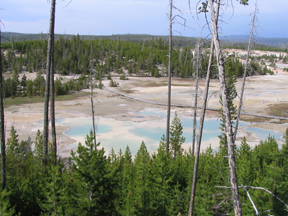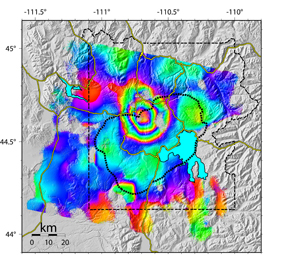Geotimes

Untitled Document

News Notes
Volcanoes
Yellowstone’s moving magma
For decades, geologists have known that land in Yellowstone National Park has
been rising and falling due to activity in a massive magma chamber that lurks
beneath the park. New satellite images are providing a testament to just how
extensive those land changes are, and what processes are controlling them.
 The heart of Yellowstone lies inside a 45-kilometer-wide by 75-kilometer-long
crater, or caldera — a remnant of an explosive volcanic eruption about
640,000 years ago that vented more than 2,500 cubic kilometers of magma (nearly
6,000 times greater than the volume erupted in the 1980 eruption of Mount St.
Helens). Within this caldera, two deep magma domes periodically have been rising
and falling since long before the last eruption in Yellowstone 70,000 years
ago, says Charles Wicks of the U.S. Geological Survey in Menlo Park, Calif.
Alongside these land changes has been the famed hydrothermal activity throughout
the park, as well as many small earthquakes.
The heart of Yellowstone lies inside a 45-kilometer-wide by 75-kilometer-long
crater, or caldera — a remnant of an explosive volcanic eruption about
640,000 years ago that vented more than 2,500 cubic kilometers of magma (nearly
6,000 times greater than the volume erupted in the 1980 eruption of Mount St.
Helens). Within this caldera, two deep magma domes periodically have been rising
and falling since long before the last eruption in Yellowstone 70,000 years
ago, says Charles Wicks of the U.S. Geological Survey in Menlo Park, Calif.
Alongside these land changes has been the famed hydrothermal activity throughout
the park, as well as many small earthquakes.
New
research is suggesting that magma located below the Norris Geyser Basin in Yellowstone
National Park periodically rises close to the surface, heating the geothermal
field, before diving back down. Photo is by Lisa M. Pinsker.
From 1997 to 2003, researchers observed a period of uplift and subsidence in
the crater using GPS measurements, and Wicks and his colleagues were hoping
to learn more. So, they turned to Synthetic Aperture Radar Interferometry (InSAR)
from a European Space Agency satellite to get a different view of the moving
magma.
InSAR mathematically combines different radar images over time to create digital
elevation models, which can reveal changes that are otherwise undetectable,
says Paul Segall, a geophysicist at Stanford University in Palo Alto, Calif.,
who is not part of Wicks’ team. What the team found was “startling,”
Segall says.
As published in the March 2 Nature, the team not only found uplift and
subsidence occurring at the domes inside the caldera as researchers had observed
in the past, but also discovered a notable 13-centimeter uplift under the north
rim of the caldera. “This uplift at the margin of the caldera could be
interpreted as showing migration of magma,” Segall says.
Indeed, Wicks and colleagues suggest that the uplift on the rim of the caldera
is probably associated with the movement of magma up and out of the caldera
through a “valve-like system” at the north rim, Wicks says. Like with
a faucet, where water is always in the pipes, magma is always present beneath
Yellowstone, he says, and the valve controls when it moves. The “slug-like
blobs” of magma crawl beneath the caldera and through the domes, inflating
and deflating the land as the magma comes and goes.
 The magma then squeezes through a small pathway at the north rim, which is
controlled by tectonic activity, Wicks says. When tectonic activity effectively
slows movement in the “faucet” to a trickle, magma builds up in the
rim and inflates it, he says. When the valve opens again, magma passes through,
spreading out beneath the geothermal Norris Geyser Basin. Below Norris, Wicks
says, as magma spreads out, it heats up the field before diving back down deep
into Earth.
The magma then squeezes through a small pathway at the north rim, which is
controlled by tectonic activity, Wicks says. When tectonic activity effectively
slows movement in the “faucet” to a trickle, magma builds up in the
rim and inflates it, he says. When the valve opens again, magma passes through,
spreading out beneath the geothermal Norris Geyser Basin. Below Norris, Wicks
says, as magma spreads out, it heats up the field before diving back down deep
into Earth.
Scientists
compiled this image of ground deformation in Yellowstone caldera using satellite
images taken from 1996 through 2000. The image shows 12.5 centimeters (5 inches)
of uplift centered within the northern end of Yellowstone caldera (black dotted
line), about 10 kilometers south of Norris Geyser Basin. Each full spectrum
of color (from red to purple) represents about 28 millimeters (1 inch) of uplift.
Image is courtesy of Charles Wicks.
Magma movement has long been hypothesized as the cause of the inflation and
deflation in Yellowstone, as well as other volcanic areas such as the Long Valley
Caldera in California and the Campi Flegrei near Naples, Italy (see Geotimes,
April 2006). Another hypothesis, however, has been that the movement of
hydrothermal fluids drives the land changes.
Wicks’ team’s suggestion that magma movement is causing the deformation
“definitely is a possibility,” Segall says. The lack of certain geochemical
signals, such as a lack of chloride in the groundwater, and the uplift across
the caldera margin “would argue against a hydrothermal hypothesis.”
Still, he says that he remains skeptical — “what is truly going on
below the surface is still quite uncertain.”
Wicks says that his team is pretty confident that magma movement is causing
the land changes, but agrees that more integration of seismic data, gravity
measurements, geochemical tests and other data can help determine changes at
depth. There’s a lot still to be done here, Segall says, and “we’re
really just scratching the surface of what we can hope to learn about volcanoes
through InSAR.”
In the end, however, studying how magma moves below Yellowstone will enable
researchers to learn more about the “normal” range of land changes
in the volcanic system, Wicks says. Now, if researchers observe an “abnormal”
land change, they may have forewarning of seismic activity and a possible eruption.
Yellowstone will erupt again, he says; it is just a matter of when and how.
Megan Sever
Links:
"Italy's hidden hazard," Geotimes, April 2006
Print
Exclusive
"Truth, fiction and everything
in between at Yellowstone," Geotimes, June 2005
Back to top
Untitled Document

 The heart of Yellowstone lies inside a 45-kilometer-wide by 75-kilometer-long
crater, or caldera — a remnant of an explosive volcanic eruption about
640,000 years ago that vented more than 2,500 cubic kilometers of magma (nearly
6,000 times greater than the volume erupted in the 1980 eruption of Mount St.
Helens). Within this caldera, two deep magma domes periodically have been rising
and falling since long before the last eruption in Yellowstone 70,000 years
ago, says Charles Wicks of the U.S. Geological Survey in Menlo Park, Calif.
Alongside these land changes has been the famed hydrothermal activity throughout
the park, as well as many small earthquakes.
The heart of Yellowstone lies inside a 45-kilometer-wide by 75-kilometer-long
crater, or caldera — a remnant of an explosive volcanic eruption about
640,000 years ago that vented more than 2,500 cubic kilometers of magma (nearly
6,000 times greater than the volume erupted in the 1980 eruption of Mount St.
Helens). Within this caldera, two deep magma domes periodically have been rising
and falling since long before the last eruption in Yellowstone 70,000 years
ago, says Charles Wicks of the U.S. Geological Survey in Menlo Park, Calif.
Alongside these land changes has been the famed hydrothermal activity throughout
the park, as well as many small earthquakes. 
 The magma then squeezes through a small pathway at the north rim, which is
controlled by tectonic activity, Wicks says. When tectonic activity effectively
slows movement in the “faucet” to a trickle, magma builds up in the
rim and inflates it, he says. When the valve opens again, magma passes through,
spreading out beneath the geothermal Norris Geyser Basin. Below Norris, Wicks
says, as magma spreads out, it heats up the field before diving back down deep
into Earth.
The magma then squeezes through a small pathway at the north rim, which is
controlled by tectonic activity, Wicks says. When tectonic activity effectively
slows movement in the “faucet” to a trickle, magma builds up in the
rim and inflates it, he says. When the valve opens again, magma passes through,
spreading out beneath the geothermal Norris Geyser Basin. Below Norris, Wicks
says, as magma spreads out, it heats up the field before diving back down deep
into Earth. 